Environmental catastrophes in fiction reflect societal fears about ecological collapse and the consequences of human actions. Common themes include climate change, pollution, and resource depletion. These narratives explore the moral dilemmas faced by characters and the urgency of sustainable practices. Regional perspectives enrich the portrayal, highlighting unique challenges and fostering empathy for affected communities.
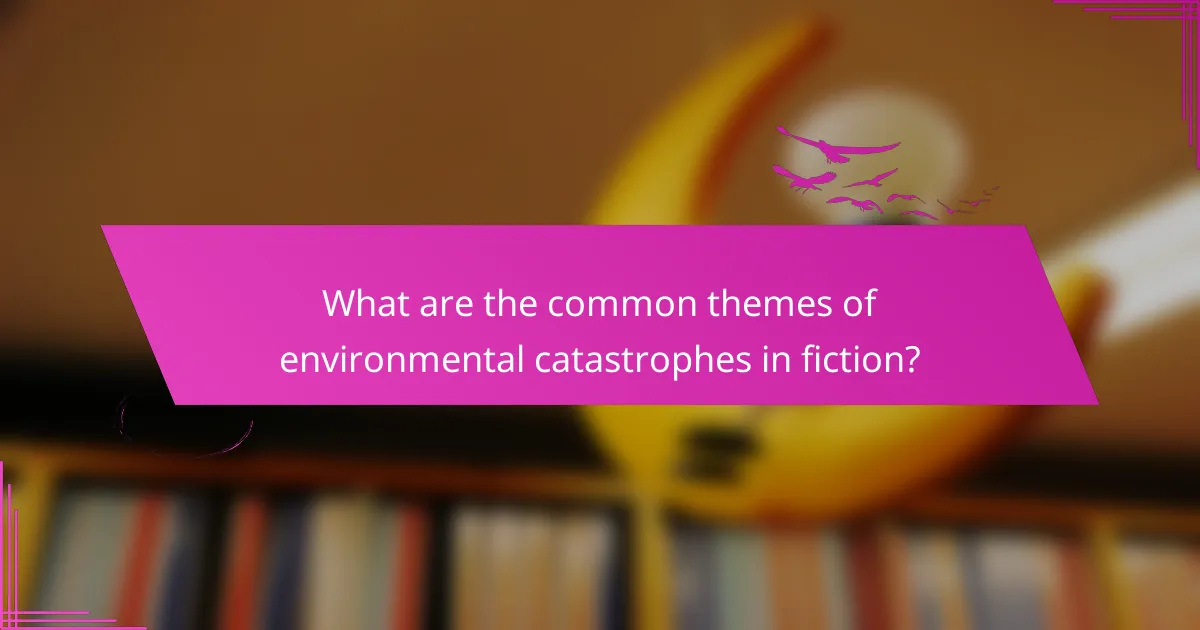
What are the common themes of environmental catastrophes in fiction?
Common themes of environmental catastrophes in fiction include human hubris, climate change, and ecological collapse. These narratives often explore the consequences of neglecting nature and the fragility of ecosystems. They reflect societal fears about the future and the impact of technology on the environment. Characters typically face moral dilemmas and the struggle for survival, highlighting resilience and adaptation. Such themes resonate with readers, prompting reflection on real-world environmental issues and the need for sustainable practices.
How do these themes reflect societal concerns?
Environmental catastrophes in fiction reflect societal concerns about climate change, resource depletion, and human impact on nature. These narratives often illustrate fears of ecological collapse and the consequences of inaction. For example, dystopian settings emphasize the urgency of environmental issues, mirroring real-world anxieties. As a result, fiction serves as a catalyst for awareness and dialogue about sustainability and environmental responsibility.
Which literary genres frequently explore these themes?
Literary genres that frequently explore environmental catastrophes include science fiction, dystopian fiction, and speculative fiction. These genres often depict the consequences of ecological disasters and highlight themes of survival, adaptation, and the impact of human actions on nature. For example, science fiction often imagines future worlds altered by climate change, while dystopian narratives illustrate societies struggling with the aftermath of environmental collapse.
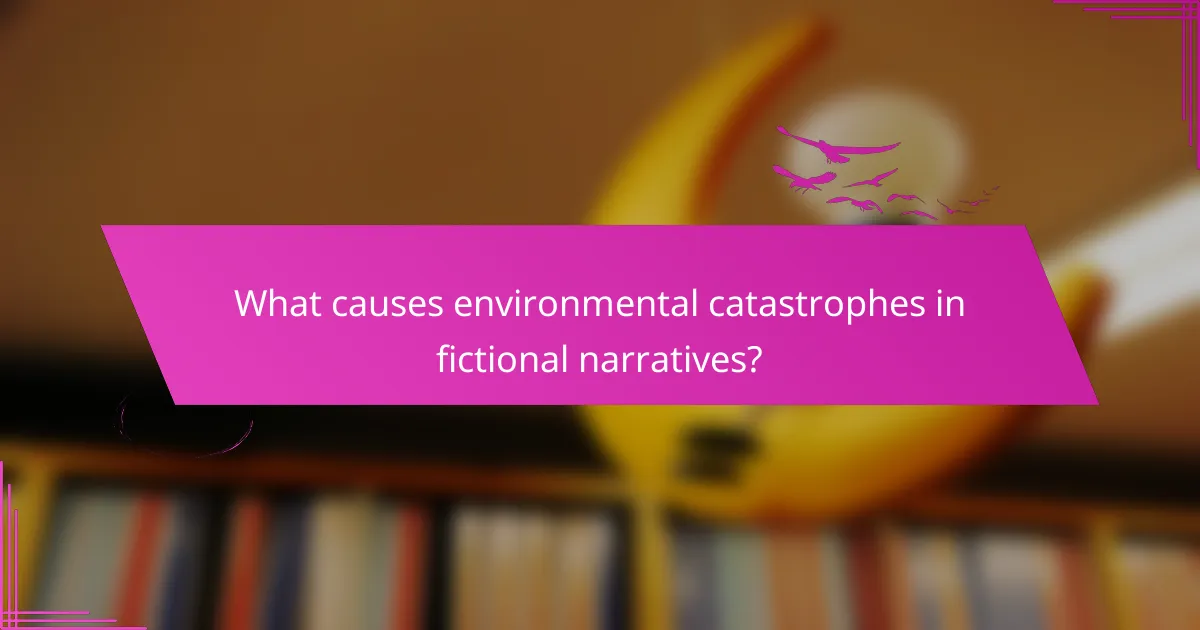
What causes environmental catastrophes in fictional narratives?
Environmental catastrophes in fictional narratives often stem from human actions, natural disasters, or technological failures. Common themes include climate change, pollution, and resource depletion. For example, in many dystopian stories, unchecked industrialization leads to environmental collapse. These narratives illustrate the consequences of neglecting ecological balance, emphasizing the urgency of sustainability.
How do human actions contribute to these fictional disasters?
Human actions significantly contribute to fictional environmental catastrophes through themes of negligence, exploitation, and technological overreach. These narratives often depict how industrialization leads to resource depletion and climate change. For example, deforestation in stories symbolizes loss of biodiversity and habitat destruction. As a result, human greed and disregard for nature create dire consequences, such as natural disasters and societal collapse. These fictional scenarios reflect real-world concerns about sustainability and environmental stewardship.
What role do natural events play in these stories?
Natural events serve as critical catalysts in environmental catastrophe narratives, driving conflict and character development. These events often symbolize broader themes such as human vulnerability and the consequences of neglecting nature. For instance, a sudden earthquake might reveal societal fractures, while a drought can illustrate resource scarcity. Such scenarios deepen the plot and underscore the fragility of ecosystems, prompting reflection on humanity’s relationship with the environment.
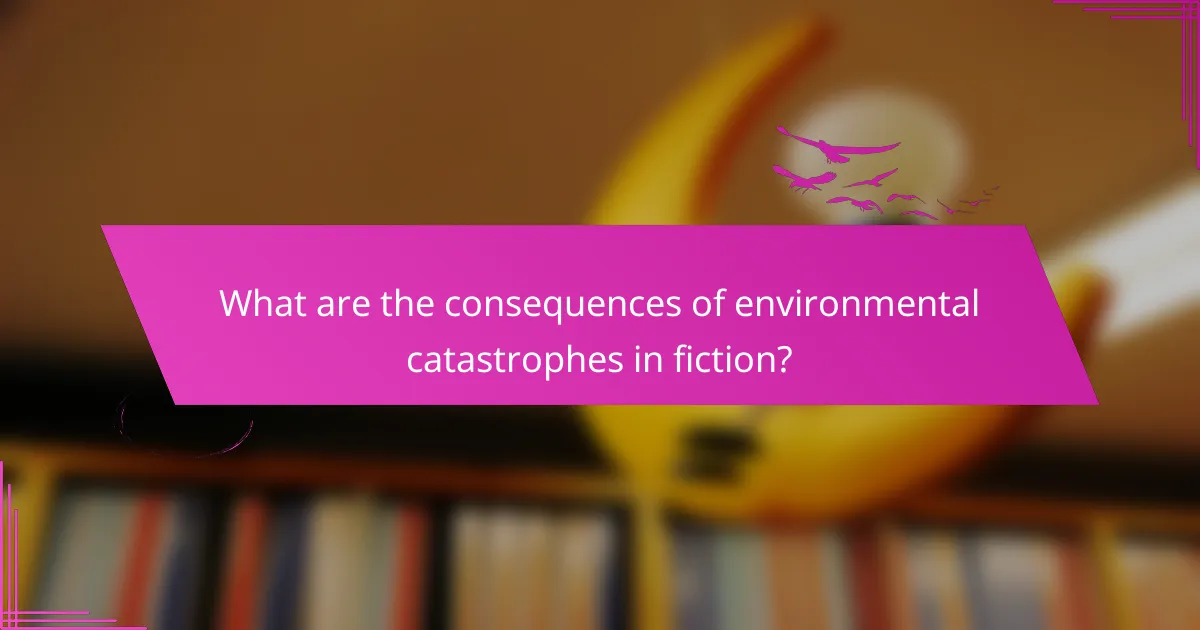
What are the consequences of environmental catastrophes in fiction?
Environmental catastrophes in fiction often lead to severe societal, psychological, and ecological consequences. Characters may experience trauma and loss, while communities face breakdowns in social order. The environment suffers from irreversible damage, impacting biodiversity and natural resources. As a result, these narratives explore themes of resilience, adaptation, and the moral implications of human actions.
How do characters respond to environmental crises?
Characters in fiction often respond to environmental crises by showcasing resilience, adaptation, and moral dilemmas. Their actions reflect broader themes of survival and humanity’s relationship with nature. For example, in post-apocalyptic narratives, characters may band together to rebuild society, highlighting themes of cooperation and hope. Alternatively, some may succumb to despair or turn to conflict, illustrating the psychological toll of environmental devastation. These varied responses serve to deepen the narrative, emphasizing the consequences of environmental catastrophes on individual and collective behavior.
What moral or ethical dilemmas arise from these scenarios?
Environmental catastrophes in fiction often present moral and ethical dilemmas. These dilemmas include the responsibility of individuals versus corporations, the prioritization of economic growth over environmental preservation, and the implications of technological interventions in nature. Characters must confront choices that reflect their values, such as sacrificing personal gain for collective well-being. Additionally, scenarios may raise questions about justice for marginalized communities disproportionately affected by environmental damage. These themes encourage readers to reflect on real-world issues and their own ethical stances regarding environmental stewardship.
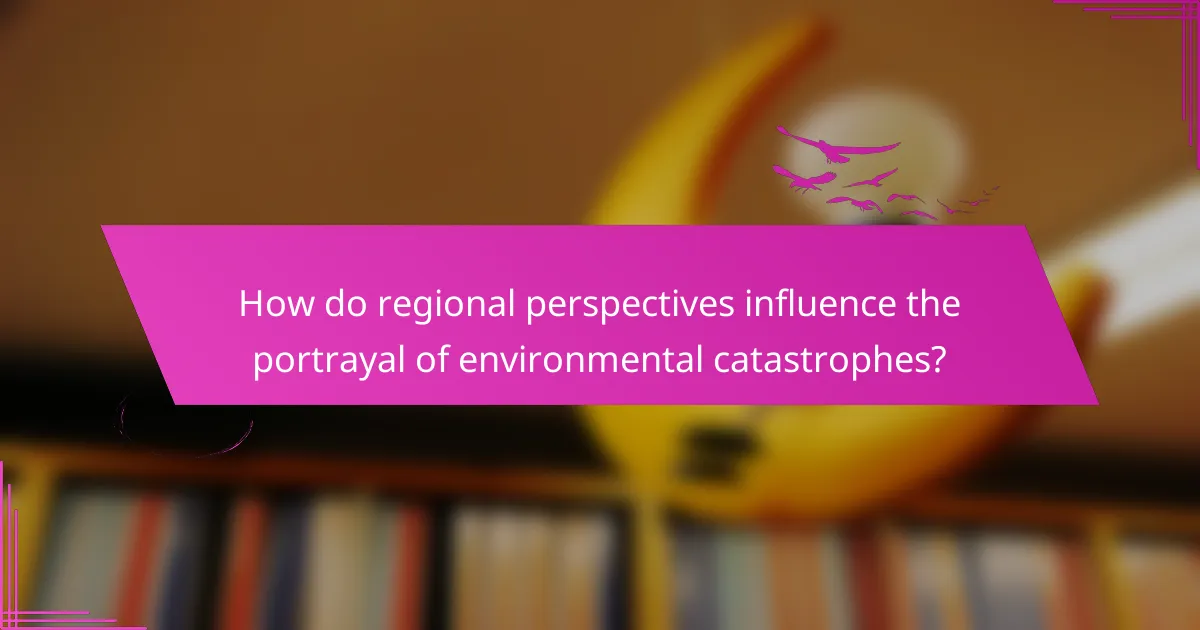
How do regional perspectives influence the portrayal of environmental catastrophes?
Regional perspectives significantly shape the portrayal of environmental catastrophes in fiction. Different cultures emphasize unique themes, such as resilience or vulnerability, influenced by local experiences and values.
For instance, coastal communities often reflect on the impacts of rising sea levels through narratives of loss and adaptation. In contrast, inland regions may focus on drought and resource scarcity, highlighting human conflict and survival.
These varying portrayals serve to raise awareness about specific environmental issues relevant to each region. They also foster empathy by connecting audiences to the lived experiences of others facing similar challenges.
Ultimately, these regional nuances enrich the narrative landscape of environmental catastrophes, making them more relatable and impactful for diverse audiences.
What unique attributes are found in North American narratives?
North American narratives often highlight unique attributes like cultural resilience, indigenous perspectives, and ecological themes. These elements shape the portrayal of environmental catastrophes, emphasizing human connection to nature. For example, stories may illustrate how communities adapt to climate change impacts, showcasing both struggle and innovation. Additionally, the incorporation of folklore and mythology enriches narratives, providing deeper insights into environmental relationships. These unique traits differentiate North American fiction from global narratives, reflecting specific regional experiences and values.
How do European authors depict environmental themes differently?
European authors depict environmental themes through diverse cultural lenses, emphasizing unique societal values and historical contexts. For example, Northern European literature often highlights the stark realities of climate change, reflecting a deep-rooted connection to nature. In contrast, Southern European narratives may focus on the impact of environmental degradation on local communities, showcasing personal stories intertwined with ecological crises. This variation reveals how different regions interpret the causes and consequences of environmental catastrophes, ultimately shaping their literary responses and societal awareness.
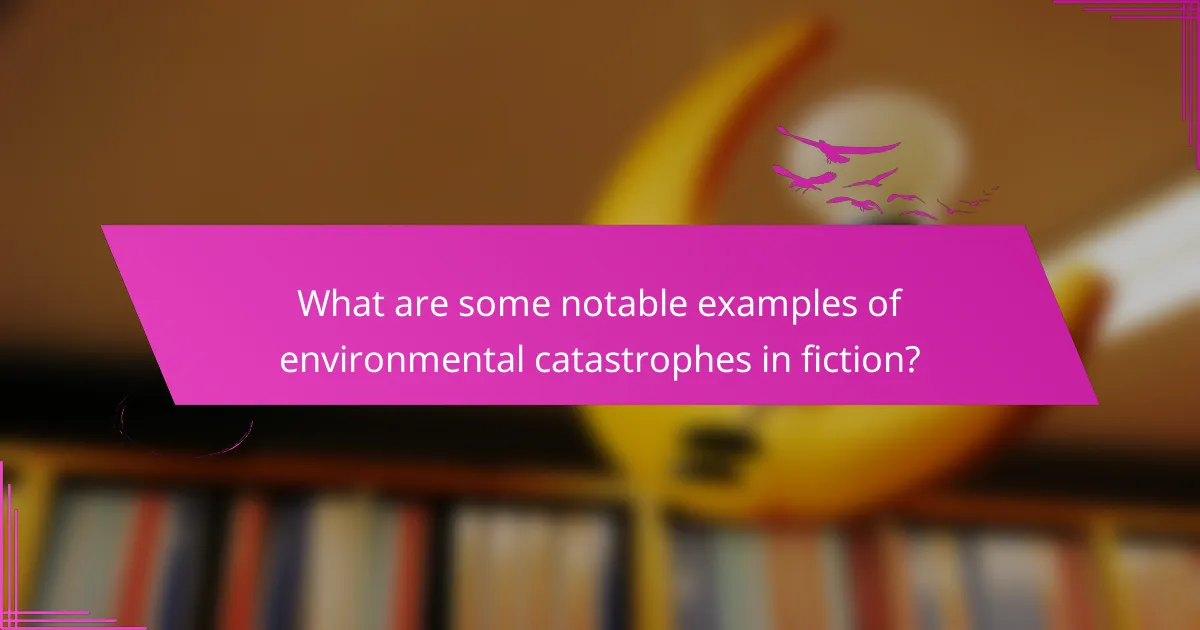
What are some notable examples of environmental catastrophes in fiction?
Notable examples of environmental catastrophes in fiction include “The Road” by Cormac McCarthy, depicting a post-apocalyptic landscape, and “Silent Spring” by Rachel Carson, which addresses pesticide pollution and its impact on ecosystems. “The Overstory” by Richard Powers illustrates deforestation’s effects on both nature and humanity. “Parable of the Sower” by Octavia Butler showcases climate change-induced societal collapse. These works highlight themes of human resilience and the dire consequences of environmental neglect.
Which works have had a significant cultural impact?
Environmental catastrophes in fiction have profoundly influenced cultural narratives and societal perceptions. Works such as “The Road” by Cormac McCarthy illustrate the psychological impact of post-apocalyptic environments, while “The Overstory” by Richard Powers explores the interconnectedness of nature and humanity. These narratives often reflect real-world environmental concerns, prompting discussions on climate change and sustainability. “Parable of the Sower” by Octavia Butler offers a unique perspective on societal collapse, emphasizing resilience amidst chaos. Such works not only entertain but also provoke critical thought about our relationship with the environment.
What lesser-known stories deserve recognition?
Many lesser-known stories highlight environmental catastrophes in fiction, showcasing diverse themes and consequences. One notable example is “The Overstory” by Richard Powers, which intertwines the lives of characters with the fate of trees, emphasizing the interconnectedness of life. Another is “Parable of the Sower” by Octavia Butler, portraying a dystopian future shaped by climate change and societal collapse, raising awareness about environmental degradation. These narratives often explore human resilience and the urgent need for ecological stewardship, making them deserving of greater recognition.

How do authors use symbolism related to environmental disasters?
Authors use symbolism related to environmental disasters to convey complex themes and provoke emotional responses. Symbolism allows writers to represent larger concepts, such as human negligence or nature’s resilience, through tangible images. For instance, a dying tree may symbolize the consequences of pollution or deforestation. This approach deepens readers’ understanding of the causes and consequences of environmental catastrophes. Additionally, unique symbols can highlight specific cultural or regional impacts, enhancing the narrative’s depth. Overall, symbolism serves as a powerful tool for exploring the intricate relationship between humanity and the environment.
What symbols are commonly associated with ecological themes?
Common symbols associated with ecological themes include trees, water droplets, recycling arrows, animals, and the Earth. These symbols represent nature, sustainability, and the interconnectedness of ecosystems. For example, a tree symbolizes life and growth, while recycling arrows signify the importance of waste reduction.
How does symbolism enhance the narrative?
Symbolism enhances narratives about environmental catastrophes by deepening emotional resonance and highlighting themes. It transforms abstract concepts into tangible elements, making complex issues relatable. For instance, a dying tree can symbolize ecological decline, prompting readers to reflect on the consequences of environmental neglect. This layered meaning enriches the story and engages the audience more profoundly, fostering a greater understanding of the ecological themes presented.
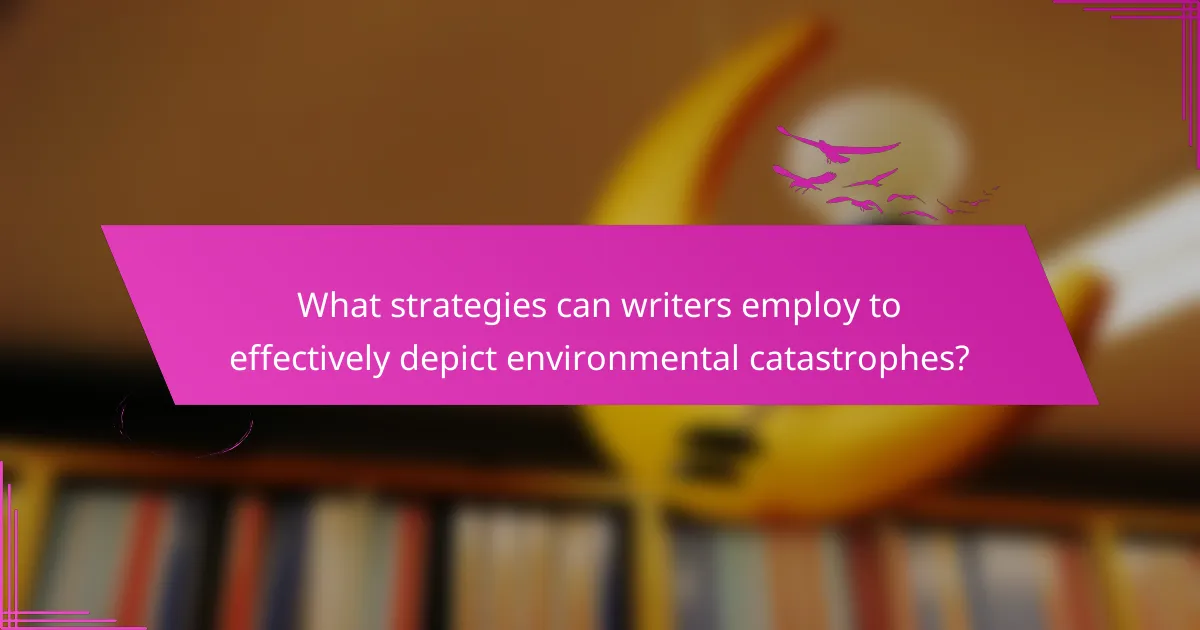
What strategies can writers employ to effectively depict environmental catastrophes?
Writers can effectively depict environmental catastrophes by employing immersive world-building, relatable characters, and vivid imagery. They should focus on the emotional and physical impacts of disasters to evoke empathy. Integrating real scientific data enhances authenticity, while exploring themes of resilience and hope can provide a balanced perspective. Utilizing multiple viewpoints can also deepen the narrative, allowing readers to grasp the multifaceted nature of such events.
What common pitfalls should be avoided in storytelling?
To avoid common pitfalls in storytelling about environmental catastrophes, focus on authenticity, avoid clichés, and ensure character development.
First, prioritize realistic representations of ecological issues. Misrepresenting facts can undermine credibility. Second, avoid overused tropes that may disengage readers. Fresh perspectives enhance engagement. Lastly, ensure characters are multidimensional, reflecting diverse responses to crises, which adds depth to the narrative.
How can research inform realistic portrayals of environmental issues?
Research can significantly enhance the realism of environmental issues depicted in fiction. By grounding narratives in scientific evidence, writers can create more authentic and relatable scenarios. Accurate portrayals of climate change, biodiversity loss, and pollution resonate with audiences, fostering awareness and empathy.
Incorporating real data on environmental impacts, such as species extinction rates or carbon emissions, can deepen the narrative’s emotional weight. For instance, a story featuring a coastal town facing rising sea levels can reflect genuine statistics about climate displacement. This connection between fiction and factual research encourages readers to engage with the urgency of environmental challenges.
Moreover, research informs character development and plot progression. Characters can be shaped by their responses to environmental catastrophes, reflecting diverse perspectives on climate action and adaptation. This complexity adds depth to the narrative, making it more compelling and thought-provoking.
Ultimately, blending rigorous research with creative storytelling enriches the portrayal of environmental issues, fostering a more informed and engaged audience.
What best practices can enhance thematic depth in narratives?
To enhance thematic depth in narratives about environmental catastrophes, focus on character development, setting realism, and moral dilemmas. Characters should embody various responses to crises, illustrating diverse human experiences. Realistic settings grounded in scientific principles increase credibility and immersion. Incorporating moral dilemmas can provoke thought and stimulate emotional engagement, encouraging readers to reflect on their values and responsibilities. These elements collectively enrich the narrative, making the themes resonate more profoundly with the audience.
